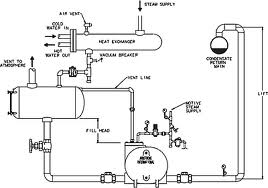 Our goal in condensate management is to recover as much of the treated water and heat energy as we can, and return this to the boiler. To that end, a significant challenge we are faced with is the potential losses via flash steam. 10% to 15% of condensate is subject to flash back to a steam state due to a drop in pressure and the corresponding pressure/temperature/volume relationship given in the steam tables. In short, a portion of the higher pressure, higher temperature condensate formed in the heat exchanger will flash to steam as it is introduced to the lower pressure, lower temperature environment existing in the condensate return system. This is a natural occurance that, while troublesome can be utilized to advantage with efficient design.
Our goal in condensate management is to recover as much of the treated water and heat energy as we can, and return this to the boiler. To that end, a significant challenge we are faced with is the potential losses via flash steam. 10% to 15% of condensate is subject to flash back to a steam state due to a drop in pressure and the corresponding pressure/temperature/volume relationship given in the steam tables. In short, a portion of the higher pressure, higher temperature condensate formed in the heat exchanger will flash to steam as it is introduced to the lower pressure, lower temperature environment existing in the condensate return system. This is a natural occurance that, while troublesome can be utilized to advantage with efficient design.
Flash steam is typically recovered with two different types of systems: open systems and closed systems. In an open system, several steam traps at various pressures discharge to a common condensate receiver that is vented to the atmosphere. The key to conserving heat in this application is in the size of the vent line. As long as the vent line is sized large enough, atmospheric pressure will be maintained in the tank and a bare minimum of steam will escape through the vent. Vent sizing is crucial and is based on the system’s condensate load. A typical problem with many systems occurs when further load is added to a previously properly sized receiver and vent. The additional load will exceed that required for the installed vent and result in steam escaping through the vent. This is often misdiagnosed as a failed steam trap(s), when a correct solution may be an increased vent line.
A closed loop system is utilized for a single piece of equipment. The vent line is tied back into the heat exchanger, allowing for an equalization in pressure. This allows the condensate to drain via gravity to the pump. There should be an appropriately-sized steam trap at the outlet of the pump. As long as the modulating steam supply off the heat exchanger is high enough to remove the condensate, the steam trap is the only operative piece of condensate removal equipment at this point in the system. If the steam supply pressure drops below the condensate back pressure, the pressure powered pump will work to remove the condensate. There is not a flash steam problem in this type system, since there is not a mixing of various steam pressures and the receiver is vented back to the exchanger. However, it is not uncommon for a condensate recovery system of this type to be fed into a separate vented receiver before condensate is returned to the boiler.
There are cases where there is an excess of flash steam that cannot be effectively dealt with through condensate tank/vent line design. In these cases, the flash steam will still escape to the atmosphere. The most common way of recovering this energy is to direct the vented steam to a point of usage, typically a low pressure heat exchanger to pre-heat domestic water, or boiler feed water, or some other process. The specifics of utilization and recovery system design will depend on the application, waste steam load, and the facility.
To summarize, flash steam is typically a given in many systems, especially with various operating pressures. However, flash steam does not necessarily equal waste steam. With efficient and often creative design, most of the energy in a typical steam system can be utilized effectively.
